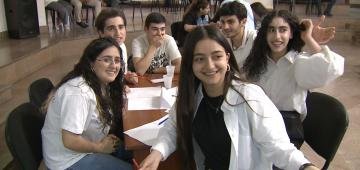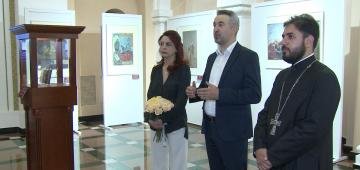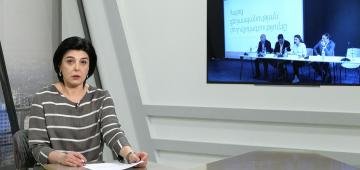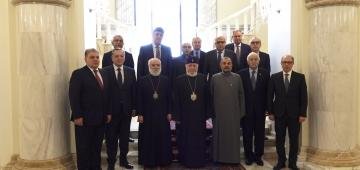 |
The winner of the intellectual festival entitled "Nation, Army, Church" is the "Gandzasar" team.
An intellectual festival titled "Nation, Army, Church" was held in the Holy Trinity Church, in which the youth of the Araratian Pontifical Diocese participated. 11 teams participated in the three-round match. The victory cup went to the "Gandzasar" team of the Holy Mother of God Church of Nork-Marash. This is the second festival held this year, the first one was held during the Saint Sargis feast under the title "The power of love is invincible".
|
 |
Hasmik Movsisyan's "250" movie
The film about children drivers from Artsakh received 17 awards
3 years ago, the press wrote about the feat of fourteen-year-old Vahe and eleven-year-old Ashot from Artsakh, who sat behind the wheel of their father's cars during the 44-day war, traveled 250 km and saved not only their relatives, but also neighbors and compatriots they met on the road. Film director Hasmik Movsisyan made a short feature film based on this story. The film "250 km" was screened at 23 film festivals around the world and received 17 awards. Hasmik Movsisyan, director, screenwriter and producer of the film, is the guest of Anahit Margaryan in "Artfocus".
|
 |
Hovhannes Shiraz, 110th anniversary, Part 2
The influence of Hovhannes Shiraz's poetry was very great in Armenia and the Diaspora. His poems dedicated to the Armenian Genocide and Western Armenia are still the focus of readers' attention. How was the poet able to address these topics that were forbidden in the Soviet period and how relevant are these works today? These questions are discussed by literary critics Hayk Hambardzumyan, Arkmenik Nikoghosyan and Samvel Muradyan in the "Parallel Readings" program.
|
 |
An exhibition dedicated to the 130th anniversary of the Persian-Armenian artist Andre Sevrugyan was opened
The exhibition titled "Poetry of Images" opened in cooperation with the Museums of Mashtots Matenadaran and Mother See of Holy Etchmiadzin is dedicated to the 130th anniversary of the Persian-Armenian artist Andre Sevrugyan. Some of the famous artist's works are stored in the vaults of both institutions. Combined in one exhibition, presented for the first time, some works have never been shown before.
|
 |
How many millions would we be today if Turkey had not committed the Armenian Genocide?
During the 70 years of Soviet Armenia, the population of Armenia increased fivefold. The population of Western Armenia before the genocide was 2.5 million, and if the genocide had not happened, then the population of Armenia could be about 13-15 million now.
Mikael Malkhasyan, candidate of historical sciences, specialist in historical demography, believes that the influence of the genocide still exists today, it is not just an event that happened 100 years ago, which affects 1.5 million people. The result of the genocide is that we have little opportunities today.
He claims that the bait of a recent public discussion about the number of Armenians subjected to genocide is a dangerous political narrative that can turn into a simplification and dissolution of the subject of international recognition of the Armenian Genocide, fair and legitimate claims.
|
 |
Harutyun Mkrtchyan after the 44-day war
A wartime contract soldier has a mission
Harutyun Mkrtchyan, a resident of Meghrashat village in Shirak region, lost his leg, his health and his childhood friend during the 44-day war. Harutyun undergoes one operation after another, but he hopes that everything will be fine, that God will protect him, because he still has work to do.
|
 |
The Catholicos of All Armenians received the "All-Armenian Council of Diplomats"
"All-Armenian Council of Diplomats" NGO President Gurgen Melikyan presented the goals and plans of the organization to the Armenian Patriarch and asked His Holiness's blessing for the activities of the newly created structure. Conveying his paternal blessing to the members of the organization, His Holiness addressed to the challenges facing Armenia, the problems and threats of protecting the fair rights of the Armenian people.
|
 |
The History Museum has collected stories of more than 200 victims of the 44-day war
A presentation of the online exhibition entitled "Eternal Travelers - Names, Stories and Dreams" was held at the History Museum of Armenia, which was supported by the AGBU. The exhibition is dedicated to the memory of the heroes who died in the 44-day war. The director of the museum stated that they have set a task to present the people who dedicated their lives to the motherland. The new and recent history section of the museum collected information about the heroes who died in the 44-day war and processed more than 200 stories.
|
 |
Hovhannes Shiraz, 110th anniversary, part 1
This year marks the 110th anniversary of the birth of Hovhannes Shiraz. What was Shiraz's entry into literature, how was he able to create works of the traditions of Armenian pastoral poetry in the times of "factory" and propaganda poetry, and what was the attitude of the literary environment towards Shiraz, especially Yeghishe Charents? These questions are discussed by literary experts Hayk Hambardzumyan, Arkmenik Nikoghosyan and Samvel Muradyan.
|
 |
The Catholicos of All Armenians received the priests of the Priest Accelerated Course
Priests undergoing training arrived at the Mother See from different dioceses of Armenia and the Diaspora. They are clergymen of different generations and different experience. The course lasted three weeks. In the first week, the priests focused on the mission of the spiritual, then the priest as a mentor, teacher, and the third week, the priest as a spiritual father in his home, in the church.
|
 |
Armenia and Azerbaijan in international courts
The Institute of Armenian Studies has organized a scientific conference "Genocide and ethnic cleansing in the 21st century". The first report was on "The legal essence of the concepts of ethnic cleansing and genocide in the context of Azerbaijani crimes against Armenians". According to international law specialist Levon Gevorgyan, the depopulation of Artsakh is a crime against humanity and a continuation of the genocidal policy implemented by Turkey at the beginning of the 20th century. The speaker especially stressed the reckless mentality of canceling Armenia's lawsuits against Azerbaijan in the international courts these days within the framework of the supposed peace process. Outside the international judicial processes, the Armenian question is nothing more than textbook material. It is very important to formulate a demand for one's own authorities not to withdraw from judicial proceedings.
|
 |
New strategy of education and science. part 155
Some officials do not understand what genocide is
Suren Manukyan, head of the Department of Comparative Genocide Studies of the Armenian Genocide Museum-Institute, believes that despite the educational process carried out in recent decades, Armenian officials do not know what genocide is. Genocide is not the killing of many people, it is not mass murder, it is an act aimed at destroying a group. According to him, before making a statement about the Genocide, it would be right for the officials to consult with the museum. Hovhannes Yeranyan discussed with Suren Manukyan in "Pavilion" the unnecessary speculations about the number of victims of the Armenian Genocide, the difference between "Genocide" and "Great Genocide".
|
